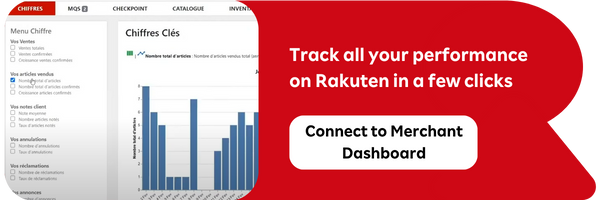How to drive your business with an e-commerce dashboard?
Do you run an e-commerce site, sell on several marketplaces or use logistics services, but find it hard to centralize your data? You’re not alone. Did you know that the average e-merchant spends over 10 hours a week manually extracting, cross-referencing and analyzing results? Precious time that could be devoted to growing sales. Without a sales reporting tool like a good e-commerce dashboard, you can quickly become overwhelmed by the sheer quantity of indicators, and your decision-making can become less precise. There’s a solution: the e-commerce dashboard. Its role is to centralize your e-commerce KPIs, enable you to choose the right indicators and give you a clear, strategic view of your business.
What is an e-commerce dashboard?
An e-commerce dashboard is a centralized management tool that brings together and presents a certain number of key performance indicators (KPIs). It gives you an instant overview of your online sales activity.
Here are the main benefits of an effective e-commerce dashboard:
- A 360° view: sales data, traffic, logistics, returns, etc., consolidated in a single dashboard tool.
- Informed decision-making: you can anticipate trends (up or down) by observing metrics in real time.
- Quickly identify problems and opportunities, such as late deliveries, critical stock or falling conversions.
- Time-saving analysis: you no longer waste hours collating manual reports.
- Better prioritization of actions: marketing, product optimization, performance-based price adjustments.
- Easier communication: between colleagues, with your partners or with your logistics provider.
- Strategic vision and continuous optimization: adjust according to results to improve overall performance.
Which solution should you choose for your e-commerce dashboard?
There are several options to consider, each with their own advantages and disadvantages. Let’s take a closer look.
Excel dashboard
The Excel dashboard can be created by hand or by downloading an existing template. It’s simple, accessible and highly customizable.
- Advantages: you don’t need an external tool, and it’s easy to set up according to your KPIs.
- Disadvantages: manual updating, risk of errors, not suitable if you have many data sources.
Good to know: alternatives such as Google Sheets, Smartsheet or LibreOffice Calc also offer all the functionality you need to set up a high-performance dashboard.
Dashboard in your CRM
Some CRMs, such as Salesforce or HubSpot, include their own sales reporting dashboard that tracks customer relationship metrics.
- Advantages: overview of the sales cycle, automated follow-ups, tracking of repeat sales or prospects.
- Disadvantages: doesn’t always cover logistics data or web/site traffic, and configuration can be complex.
Dashboard integrated into your marketplace
Another option is to use a merchant dashboard integrated directly into your marketplace. This is the case, for example, with Rakuten’s Merchant Dashboard. This comprehensive e-commerce tool is designed for marketplace sellers. In just a few clicks, it provides an overview of your business: sales, ad management, returns and logistics.
It also integrates shipping data via Rakuten Fulfillment Network, our turnkey solution that centralizes storage, order preparation and delivery.
- Advantages: easy to use, 100% integrated with the marketplace, with reliable, up-to-date data.
- Disadvantages: covers only Rakuten-related activity (to be completed if you sell on other platforms).
Dedicated Business Intelligence (BI) tools
Business Intelligence tools enable you to group and consolidate your data from multiple sources (e-commerce site, marketplaces, CRM, logistics platform…) into a single, customized dashboard.
- The benefits: high analytical accuracy, extensive customization, clear visualization and reports updated almost in real time. These tools make it easier to identify trends, correlations or anomalies that simpler solutions fail to detect.
- Disadvantages: they generally require technical skills or the intervention of a specialized service provider, and can represent a significant cost depending on the complexity of the requirements.
Examples: Google Data Studio, Power BI, Tableau. Related tools such as ERP (Enterprise Resource Planning) or PSP (Payment Service Provider) can also integrate sales reporting modules or logistics indicators, thus broadening the scope of possible analysis.
Which KPIs should you include in your e-commerce dashboard?
Not all e-commerce KPIs are relevant to your online sales operations. Here are the KPIs to add to your e-commerce dashboard, how to calculate them and the type of concrete action they enable you to initiate.
Sales KPIs
The key performance indicators linked to sales are as follows:
- Number of sales: total volume of orders. It enables you to monitor the growth or sluggishness of your business.
→ If this figure is stagnating, launch a promotional operation or improve the prominence of your products on the marketplace. - Average Order Value (AOV) = Total sales ÷ Number of orders. This shows the value generated per order.
→ To increase it, you can offer cross-selling or encourage the purchase of complementary products (upselling). - Repeat purchases = customers with ≥ 2 purchases ÷ total number of customers. It reflects your ability to build loyalty.
→ To improve this rate, set up a loyalty program or exclusive post-purchase offers, for example. - Basket abandonment rate = (number of abandoned baskets ÷ total number of baskets created) × 100. It highlights friction points in the purchasing journey.
→ To reduce it, simplify the order funnel, offer several payment methods and automate reminders. - Sales: total amount of sales. It enables you to measure the overall efficiency of your business.
→ In the event of a drop, analyze your underperforming categories and adjust your marketing priorities. - Gross / net margin: gross margin = (sales – cost of goods sold) ÷ sales × 100. Net margin: net profit ÷ sales × 100. This allows you to monitor profitability by product or category.
→ If margins are falling, renegotiate your purchasing costs, adjust your prices or reduce certain operating expenses.
KPIs related to web traffic
The KPIs that tell you about your web traffic performance are:
- Number of unique visitors: indicates site attractiveness.
Action: invest in SEO or advertising. - Pages viewed per visit, time spent: measures engagement.
Action: improve content and optimize navigation. - Source of traffic (SEO, social networks, advertising, email): find out where your prospects are coming from.
Action: adjust budget according to channels. - Visitor-to-Buyer conversion rate: visitors who go on to purchase. This is a key indicator for making your ads, product sheets and order funnel more reliable.
Cost-related KPIs
Costs are essential KPIs for monitoring the profitability of your business. Here are the ones to keep a close eye on:
- Customer acquisition cost (CAC): total spent on marketing ÷ number of new customers.
→ If this cost is too high, you need to optimize your marketing campaigns, adjust your targeting or work on converting existing visitors. - Logistics costs: storage, order preparation and shipping.
→ To reduce these, consider optimizing your storage management, renegotiating your contracts with your carriers or outsourcing this part of your business via a solution like Rakuten Fulfillment Network (RFN). - Marketing/advertising costs: track spend for each channel, ROAS.
→ In the event of insufficient return, adjust your investments according to the most profitable channels. - Fixed vs. variable costs: fixed costs include rent, subscriptions or salaries. Variable costs depend directly on your business (packaging, shipping costs, commissions, etc.).
→ Analyzing this breakdown helps you better understand your break-even point and identify the items you can act on to optimize your margins.
Logistics KPIs
And finally, the performance indicators that concern logistics are as follows:
- Average delivery time: this is the time elapsed between the order and receipt by the customer.
➝ This KPI is essential, as it directly influences customer satisfaction and the likelihood of a new purchase. - Product returns rate: this corresponds to the proportion of returned products in relation to the number of sales made
➝ A high rate may indicate problems with product description, quality or correspondence with customer expectations. - Out-of-stock rate: this is the length of time your products are not available for sale.
➝ To limit this phenomenon, you can improve your forecasts, set up automatic alerts and strengthen your stock management. - Order Fulfillment time: this is the time between receiving an order and dispatching it.
➝ This time can be reduced by optimizing picking, improving packaging and integrating automated logistics solutions.
Best practices for using your e-commerce dashboard
A powerful dashboard is only useful if it’s used properly. To get the most out of your indicators, you need to adopt certain habits right from the start.
- Define precise objectives: each of the selected e-commerce KPIs must correspond to a measurable goal.
- Update the KPI dashboard at an appropriate frequency: daily for sales, weekly or monthly for costs and loyalty metrics.
- Interpret the data: you can’t just look at the figures. Identify trends or anomalies.
- Act on insights: use your data to learn, understand and implement actionable strategies (optimizations, new campaigns and adjustments).
- Share results with your teams for greater visibility and to empower everyone involved.
- Ensure scalability: add KPIs or sources as your business grows or new tools are added.
To conclude:
Without a good logistics dashboard, you risk losing time, opportunities and clarity. A well-designed KPI dashboard allows you to focus your efforts on what really matters: selling, improving and building loyalty. With the right indicators, the right solution (Excel, marketplace dashboard, CRM, BI tool), and discipline in tracking, you take control of your business. Start building your sales reporting dashboard today


